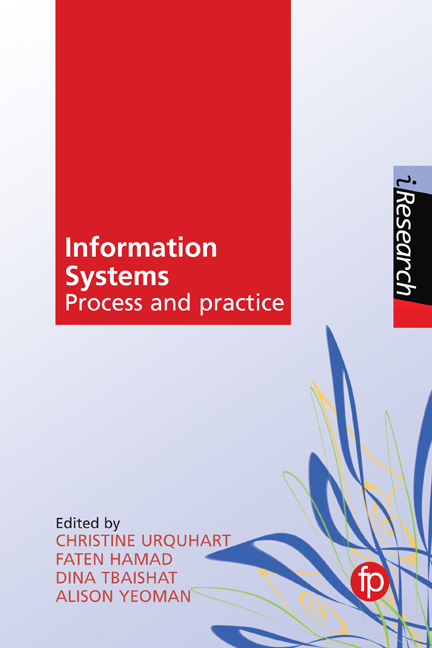Book contents
- Frontmatter
- Contents
- List of tables and figures
- Series editor's foreword
- About the authors
- 1 Introduction
- 2 Approaches to information architecture
- 3 Taxonomy testing for information architecture
- 4 The enterprise website and its information structures
- 5 Analysing activities, roles and processes
- 6 Libraries and the organisation of library processes – a history of operational research, and the use of process modelling
- 7 Using Riva process modelling to study book acquisition in academic libraries
- 8 Workflow analysis and process mapping in US academic libraries
- 9 A theoretical framework for designing and evaluating semi-structured document triage interfaces
- 10 Resource discovery case studies
- 11 Increasing social connection through a community-of-practice-inspired design
- 12 Methods for studying information provision, networking and communication in patient support groups
- 13 Health information systems: clinical data capture and document architecture
- 14 Producing systematic reviews and getting evidence to the clinician
- Index
4 - The enterprise website and its information structures
Published online by Cambridge University Press: 08 June 2018
- Frontmatter
- Contents
- List of tables and figures
- Series editor's foreword
- About the authors
- 1 Introduction
- 2 Approaches to information architecture
- 3 Taxonomy testing for information architecture
- 4 The enterprise website and its information structures
- 5 Analysing activities, roles and processes
- 6 Libraries and the organisation of library processes – a history of operational research, and the use of process modelling
- 7 Using Riva process modelling to study book acquisition in academic libraries
- 8 Workflow analysis and process mapping in US academic libraries
- 9 A theoretical framework for designing and evaluating semi-structured document triage interfaces
- 10 Resource discovery case studies
- 11 Increasing social connection through a community-of-practice-inspired design
- 12 Methods for studying information provision, networking and communication in patient support groups
- 13 Health information systems: clinical data capture and document architecture
- 14 Producing systematic reviews and getting evidence to the clinician
- Index
Summary
COMMENTARY: CHRISTINE URQUHART
Sally Burford's grounded theory of practising web information architecture is a contrast to the project phases advocated by many information architecture consultants. There are echoes here of earlier information systems research that demonstrated that design and implementation was a messy process, not something neat where packages of activities followed each other in a logical and orderly sequence. Rosenfeld, Morville and Arango (2015, 356) describe an information architecture strategy as organising and structuring an information environment to provide direction and scope, before moving into the design and implementation phase. However, they acknowledge that, in practice, the business strategy is likely to co-evolve with the information architecture (358).
One question that interested me when reading Sally Burford's research was whether there were aspects of the four foundational constructs (owning information architecture, negotiating information architecture, enacting information architecture, knowing information architecture) that were missing from some of the classic advice on information architecture. Table 4.1 illustrates the components Burford identified, set against comments other information architecture consultants or researchers made. As far as possible, I have used library and information service case studies, and references to other chapters in the book.
I have not done a comprehensive search to find examples, but it is likely that the areas identified by Burford, and which may be overlooked (or perhaps dealt with implicitly), concern governance, making the most of opportunities (and acting fast), and trying to ensure that organisational learning about information architecture takes place across the organisation.
If, as Burford indicates, practising information architecture often comes with fuzzy responsibilities, the need to connect with many different aspects of the organisation (marketing, customer services), and is an emerging practice, then how can those involved make the communication easier? Chapter 7 discusses how the process architecture may be obtained, and stresses the importance for libraries of relating to the main functions of the organisation. Elmendorf, Hinton and Hoff (2015) look at other modelling techniques that help the information architecture team and the organisation understand what the problem space includes, before moving on to resolving how to meet the needs. Seeing the problems visually as a conceptual model helps everyone involved to appreciate what the priorities really are.
- Type
- Chapter
- Information
- Information SystemsProcess and Practice, pp. 49 - 70Publisher: FacetPrint publication year: 2017



